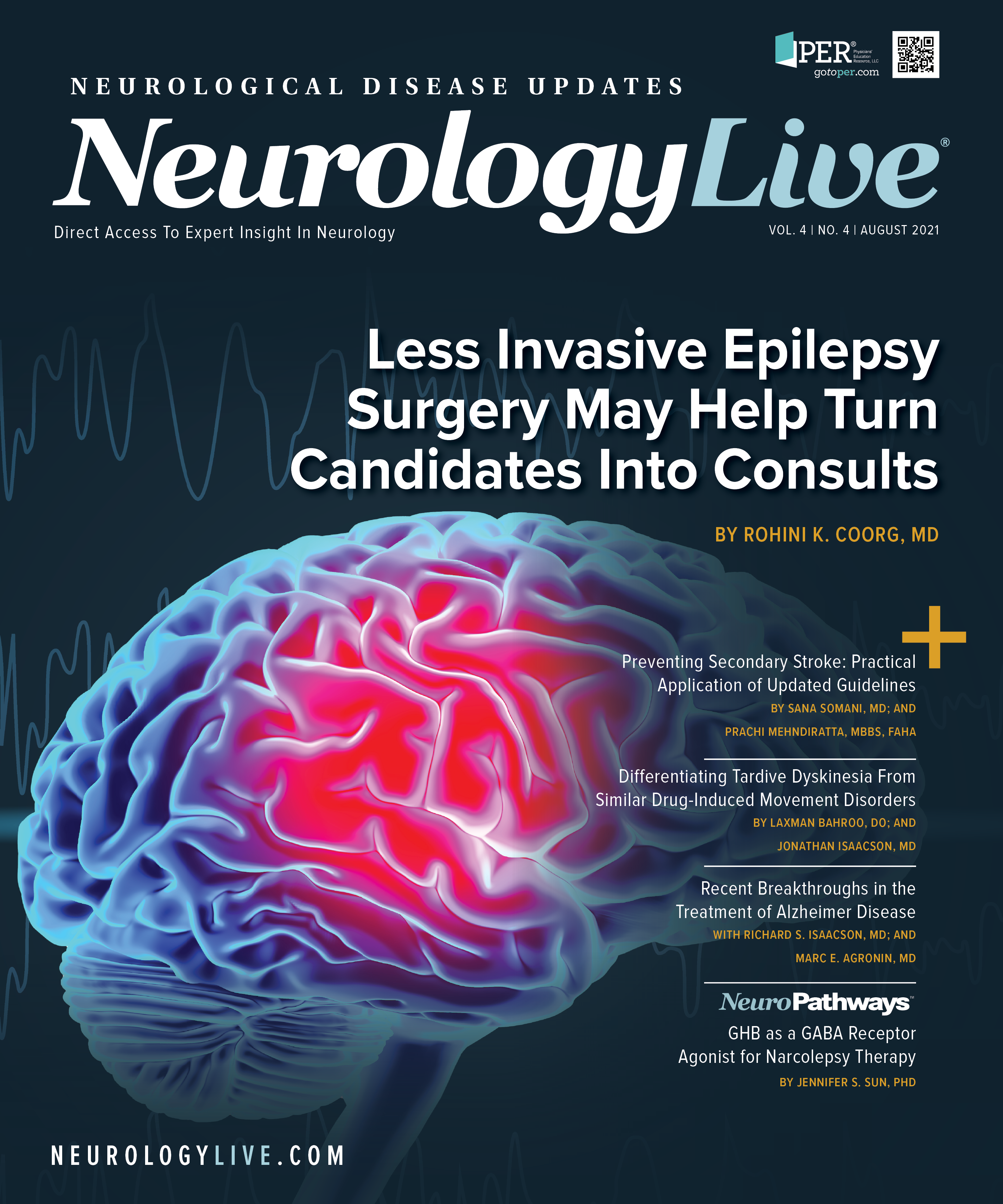Publication
Article
NeurologyLive
Differentiating Tardive Dyskinesia From Similar Drug-Induced Movement Disorders
Author(s):
Tardive dyskinesia can present many challenges in its treatment and can be difficult to differentiate from similar disorders.
Laxman Bahroo, DO

THE DIAGNOSTIC AND STATISTICAL MANUAL OF MENTAL DISORDERS, FIFTH EDITION, defines tardive dyskinseia (TD) as involuntary choreiform or athetoid movements caused by exposure to dopamine receptor–blocking agents that persist beyond 4 to 8 weeks. TD displays heterogeneity in phenomenology and can present as dystonia, akathisia, stereotypy, tics, myoclonus, tremor, or chorea. Typically, it manifests as involuntary stereotypic movements of the oral-buccal-lingual area with such movements as lip smacking, facial grimacing, and tongue movement.1 TD can also manifest with repetitive movements of the limbs, including foot tapping, complex stereotypical finger and toe movements, and repetitive rocking and swaying movements of the trunk.2 TD may also involve the laryngeal, pharyngeal, and diaphragmatic muscles.3
It is important to understand that TD is a separate entity from extrapyramidal symptoms (EPSs) and neuroleptic-induced parkinsonism. Parkinsonism can occur at any time during exposure to a neuroleptic, though removing or reducing the agent may improve EPSs and parkinsonism. In TD, the removal of the agent rarely completely reverses symptoms and may unmask or precipitate symptoms.4
Clinical Impact and Causes of TD
The impact of TD is vast. In a meta-analysis of patients on first-generation antipsychotics (FGAs) and second-generation antipsychotics (SGAs), it was found that 25.3% of patients suffered from TD.5 Although rates were higher in FGA at 30%, SGAs still had a prevalence of 20.7%. This is further pronounced given the higher frequency of SGA use in recent years for severe depression, bipolar disorder, and behavioral disturbances in elderly patients.
TD also has significant consequences on quality of life and daily functioning, including impaired gait and posture, gastrointestinal function, disrupted speech, respiration, and psychosocial complications such as occupational impairment, social stigmatization, depression, and even suicide.6 Although prior studies were isolated to patients on FGAs or with underlying schizophrenia, the expanded and broader use of antipsychotics to include patients who are highly functional will likely result in the distressing impact on quality of life of TD to be even more pronounced.7 In the RE-Kinect trial (NCT03062033), it was shown that 75.5% of patients in the possible TD cohort (n = 204) were aware of their TD symptoms, and found that even mild symptoms can have a large impact on their quality of life and ability to participate in daily activities such as the ability to take care of themselves, socialize, be productive, and even talk and eat.8
Jonathan Isaacson, MD

Long-term exposure to first- and second-generation neuroleptics is the most common cause of TD. Less common causes are the use antiemetic drugs, selective serotonin reuptake inhibitors, lithium, and tricyclic antidepressants. Factors that affect the development of TD are age, duration of illness and cumulative dose, potency of neuroleptic, female sex, prior brain damage, concurrent mood disorders, substance use, and gene polymorphisms.9
Common Misconceptions
There are many misconceptions about TD. Although EPS resolves with discontinuation of neuroleptics, TD rarely resolves with removal of the agent. The complete reversibility of symptoms was between 2% and 20% of patients after discontinuing the agent.10,11 Although FGAs certainly have the highest risk, SGAs also carry a significant risk of TD. The expanded use of SGAs for depression, bipolar disorder, and delirium in the elderly population has increased the prevalence of TD in recent years.5 TD is often minimalized as unbothersome, but as the RE-Kinect trial findings illustrate, the effect of TD on quality of life and daily living can be intrusive and distressing.
Treatment for TD
Since TD's discovery, treatment has been a challenge for clinicians. Attempts at decreasing the dose or removing the offending agent are fraught with not only the worsening of patients’ underlying psychiatric disorder, but also futility, as removal of the medication rarely cures TD. Furthermore, complete removal of the dopamine receptor blocking agent (DRBA) typically acutely worsens TD symptoms, but continuance of the DRBA may potentially cause a worsening of symptoms.12 These challenges have led to an unmet need for medications that treat TD symptoms.
VMAT2 Inhibitors
Reversible vesicular monoamine transporter-2 (VMAT2) inhibitors work by blocking a neurotransmitter transporter that packages dopamine, noradrenalin, serotonin, and histamine into presynaptic vesicles for release into the synaptic cleft.13 By blocking the transporter, less of the neurotransmitter will be packaged into the presynaptic vesicle, and less neurotransmitter will act on the postsynaptic receptor.14
Tetrabenazine was first approved for Huntington disease (HD) in 2008 to treat chorea and hyperkinetic movements. Its use was later expanded to include off-label treatment of other hyperkinetic movement disorders. Tetrabenazine is a high-affinity, reversible VMAT2 inhibitor. The half-life of tetrabenazine is short, the agent therefore requires thrice-daily dosing. It has been shown to be effective and well tolerated in multiple studies but is somewhat limited by its adverse effects (AEs) including somnolence, parkinsonism, and severe depression and suicidality.15
Deutetrabenazine (Austedo; Teva) is another available reversible VMAT2 inhibitor. Deutetrabenazine is very similar to tetrabenazine, with the main difference being the deuterium replacing the hydrogen ion in the agent. The deuterium results in a slowed metabolic clearance and lower maximum concentration value. This results in favorable a pharmacokinetic profile, with a half-life of 9 to 10 hours and twice-daily dosing. The medication must also be taken with food. Deutetrabenazine was approved by the FDA in 2017 and was the second approved therapy for both HD and TD.
The AIM-TD study (NCT02291861) included 298 patients with moderate to severe TD and assessed Abnormal Involuntary Movement Scale (AIMS) scores at 12 weeks in those randomized to receive at least 1 dose of placebo (n = 74), deutetrabenazine 12 mg/ day (n = 75), 24 mg/day (n = 74), or 36 mg/day (n = 75). The study reported a statistically significant change in AIMS score from baseline to week 12 of –3.3 points (standard error, [SE], 0.42) in the deutetrabenazine 36-mg/day group, –3.2 points (SE, 0.45) in the 24-mg/day group, and –2.1 points (SE, 0.42) in the 12-mg/day group. This equaled a treatment difference of –1.9 points (SE, 0.58; 95% CI –3.09 to –0.79; P = .001), –1.8 points (SE, 0.60; 95% CI, –3.00 to –0.63; P = .003), and –0.7 points (SE, 0.57; 95% CI, –1.84 to 0.42; P = .217), respectively, compared with –1.4 points (SE, 0.41) in the placebo group.16
Another study, ARM-TD (NCT02195700), included 117 patients in a 12-week assessment compared with placebo in a randomized, double-blind, multicenter manner. In addition to AIMS, this study also evaluated Clinical Global Impression (CGI) and Patient Global Impression (PGI) scores. In ARM-TD, deutetrabenazine significantly reduced AIMS scores from baseline to week 12 compared with placebo, with the treatment arm seeing a change of –3.0 (SE, 0.45) and the placebo arm a change of –1.6 (SE, 0.46; P = .019). Treatment success on CGI (48.2% vs 40.4%) favored deutetrabenazine but was not significant.17 The most common AEs with this agent are headaches, somnolence, and parkinsonism.
Another option is valbenazine (Ingrezza; Neurocrine), a novel, highly selective reversible VMAT2 inhibitor. It consists of an α-enantiomer and 2 isomers, which all have VMAT2 binding. The half-life is 20 hours, which allows for once-daily dosing. It can be taken with or without food. Valbenazine was approved in 2017 and was the first FDA-approved therapy for TD. KINECT 3 (NCT02274558) was a phase 3 trial with 234 patients with TD randomized to placebo, 40-mg valbenazine, and 80-mg valbenazine for 6 weeks. The primary end point was change in AIMS score. AIMS score changed by –3.2 in the 80-mg valbenazine arm, –1.9 in 40-mg arm, compared with –0.1 in placebo arm (P <.001), corresponding to an effect size of 0.90. Common AEs include somnolence, akathisia, and dry mouth.18
Other Therapies
Amantadine has long been used for its antiparkinsonism effects and has been expanded to include the treatment for patients with TD. It works by noncompetitive antagonism to N-methyl-D-aspartate acid receptors. It is postulated that it increases dopamine release and prevents reuptake.19 One 18-week, crossover, randomized controlled trial used amantadine 300 mg in addition to a neuroleptic and observed a 15% reduction in AIMS scores.20 Amantadine with a neuroleptic has level C evidence for the treatment of TD.
Vitamin E has also been studied for the treatment of TD. It is postulated that its antioxidant properties may have an effect on the disease. Although, in one trial of 158 patients who were given 1600 IU of vitamin E compared with placebo, there was no difference in AIMS scores.21 In other class 2 and 3 studies there were reductions in AIMS scores ranging from 8.5% to 43% reduction of AIMS.22 Given these conflicting studies, there is currently insufficient data to determine the efficacy of vitamin E in TD.
Ginkgo biloba is a tree native to China used for centuries in traditional medicine. The leaves contain terpenoids and flavonoids, which have antioxidant properties. In one randomized controlled trial of 157 patients, individuals were given 240 mg of gingko or placebo. The AIMS scores improved by 2.13 in the gingko arm vs –0.10 in placebo.23 Gingko as such has level B evidence, deemed as probably useful, but data are limited.
Botulinum toxin A is an adjunct therapy for the treatment of TD. Botulinum toxin A has the most evidence for its use in focal TD. In a single-blind study with 12 patients, there was a nonsignificant reduction in orofacial movements with botulinum toxin A (P = .15). However, when controlling for medication changes, there was a significant reduction for patients on stable dose of antipsychotic (P = .035). Half (50%; n = 6) of patients preferred to continue treatment with botulinum toxin A.24 Other smaller case reports showed evidence of efficacy in persistent TD with tongue protrusion that improved with botulinum toxin A.25 Further studies are needed to better display efficacy.
Clinical Takeaways and Conclusion
TD has long been underrecognized and suboptimally treated, creating a challenge to adequately treat patients with this disorder. In 2017, the approval of valbenazine and deutetrabenazine revolutionized the treatment of TD. Both demonstrated safety, efficacy, and tolerability in clinical trials. Although these therapeutics are now available, diagnostic challenges still remain. The incidence of TD has grown in recent years and the trend is likely to continue given the widened indications for DRBAs. Obstacles, in terms of awareness, screening, and surveillance remain, but these new therapeutics offer a major key to enhancing the lives of thousands.
REFERENCES
1. Correll CU, Kane JM, Citrome LL. Epidemiology, prevention, and assessment of tardive dyskinesia and advances in treatment. J Clin Psychiatry. 2017;78(8):1136-1147. doi:10.4088/JCP.tv17016ah4c
2. Waln O, Jankovic J. An update on tardive dyskinesia: from phenomenology to treatment. Tremor Other Hyperkinet Mov (N Y). 2013;3:tre-03-161-4138-1. doi:10.7916/D88P5Z71
3. Casey DE. Tardive dyskinesia: pathophysiology and animal models. J Clin Psychiatry. 2000;61 Suppl 4:5-9.
4. Wolf MA, Yassa R, Llorca PM. Neuroleptic-induced movement disorders: historical perspectives. Encephale. 1993;19(6):657-661.
5. Carbon M, Hsieh CH, Kane JM, Correll CU. Tardive dyskinesia prevalence in the period of second-generation antipsychotic use: a meta-analysis. J Clin Psychiatry. 2017;78(3):e264-e278. doi:10.4088/JCP.16r10832
6. Yassa R, Jones BD. Complications of tardive dyskinesia: a review. Psychosomatics. 1985;26(4):305-307, 310, 312-313. doi:10.1016/S0033-3182(85)72863-0
7. Caroff SN, Ungvari GS, Cunningham Owens DG. Historical perspectives on tardive dyskinesia. J Neurol Sci. 2018;389:4-9. doi:10.1016/j.jns.2018.02.015
8. Caroff SN, Yeomans K, Lenderking WR, et al. RE-KINECT: a prospective study of the presence and healthcare burden of tardive dyskinesia in clinical practice settings. J Clin Psychopharmacol. 2020;40(3):259-268. doi:10.1097/JCP.0000000000001201
9. Frei K. Tardive dyskinesia: Who gets it and why. Parkinsonism Relat Disord. 2019;59:151-154. doi:10.1016/j.parkreldis.2018.11.017
10. Glazer WM, Morgenstern H, Schooler N, Berkman CS, Moore DC. Predictors of improvement in tardive dyskinesia following discontinuation of neuroleptic medication. Br J Psychiatry. 1990;157:585-92. doi:10.1192/bjp.157.4.585
11. Zutshi D, Cloud LJ, Factor SA. Tardive syndromes are rarely reversible after discontinuing dopamine receptor blocking agents: experience from a university-based movement disorder clinic. Tremor Other Hyperkinet Mov (N Y). 2014;4:266. doi:10.7916/D8MS3R8C
12. Aia PG, Revuelta GJ, Cloud LJ, Factor SJ. Tardive dyskinesia. Curr Treat Options Neurol. 2011;13(3):231-241. doi:10.1007/s11940-011-0117-x
13. Solmi M, Pigato G, Kane JM, Correll CU. Treatment of tardive dyskinesia with VMAT-2 inhibitors: a systematic review and meta-analysis of randomized controlled trials. Drug Des Devel Ther. 2018;12:1215-1238. doi:10.2147/DDDT.S133205
14. Teo JT, Edwards MJ, Bhatia K. Tardive dyskinesia is caused by maladaptive synaptic plasticity: a hypothesis. Mov Disord. 2012;27(10):1205-1215. doi:10.1002/mds.25107
15. Miguel R, Mendonça MD, Barbosa R, et al. Tetrabenazine in treatment of hyperkinetic movement disorders: an observational study. Ther Adv Neurol Disord. 2017;10(2):81-90. doi:10.1177/1756285616677004
16. Anderson KE, Stamler D, Davis MD, et al. Deutetrabenazine for treatment of involuntary movements in patients with tardive dyskinesia (AIM-TD): a double-blind, randomised, placebo-controlled, phase 3 trial. Lancet Psychiatry. 2017;4(8):595-604. doi:10.1016/S2215-0366(17)30236-5
17. Fernandez HH, Factor SA, Hauser RA, et al. Randomized controlled trial of deutetrabenazine for tardive dyskinesia: the ARM-TD study. Neurology. 2017;88(21):2003-2010. doi:10.1212/WNL.0000000000003960
18. Hauser RA, Factor SA, Marder SR, et al. KINECT 3: A phase 3 randomized, double-blind, placebo-controlled trial of valbenazine for tardive dyskinesia. Am J Psychiatry. 2017;174(5):476-484. doi:10.1176/appi.ajp.2017.16091037
19. Bailey EV, Stone TW. The mechanism of action of amantadine in Parkinsonism: a review. Arch Int Pharmacodyn Ther. 1975;216(2):246-262.
20. Angus S, Sugars J, Boltezar R, Koskewich S, Schneider NM. A controlled trial of amantadine hydrochloride and neuroleptics in the treatment of tardive dyskinesia. J Clin Psychopharmacol. 1997;17(2):88-91. doi:10.1097/00004714-199704000-00004
21. Correll CU, Leucht S, Kane JM. Lower risk for tardive dyskinesia associated with second-generation antipsychotics: a systematic review of 1-year studies. Am J Psychiatry. 2004;161(3):414-425. doi:10.1176/appi.ajp.161.3.414
22. Barak Y, Swartz M, Shamir E, Stein D, Weizman A. Vitamin E (alpha-tocopherol) in the treatment of tardive dyskinesia: a statistical meta-analysis. Ann Clin Psychiatry. 1998;10(3):101-105. doi:10.1023/a:1022349920283
23. Allen RM. Palliative treatment of tardive dyskinesia with combination of amantadine-neuroleptic administration. Biol Psychiatry. 1982;17(6):719-727
24. Slotema CW, van Harten PN, Bruggeman R, Hoek HW. Botulinum toxin in the treatment of orofacial tardive dyskinesia: a single blind study. Prog Neuropsychopharmacol Biol Psychiatry. 2008;32(2):507-509. doi:10.1016/j.pnpbp.2007.10.004
25. Aguilar L, Lorenzo C, Fernández-Ovejero R, Roncero C, Montejo AL. Tardive dyskinesia after aripiprazole treatment that improved with tetrabenazine, clozapine, and botulinum toxin. Front Pharmacol. 2019;10:281. doi:10.3389/fphar.2019.00281





